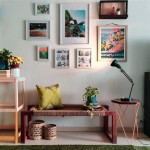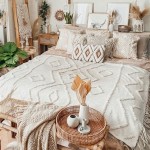How to Decorate Your Bedroom: A Comprehensive Guide
The bedroom serves as a sanctuary, a personal space dedicated to rest, relaxation, and rejuvenation. As such, its decoration should prioritize comfort and reflect the occupant’s individual style. An effectively decorated bedroom can foster a sense of tranquility and contribute significantly to overall well-being. This article provides a comprehensive guide to bedroom decoration, encompassing various elements that contribute to a harmonious and aesthetically pleasing environment.
Understanding Your Personal Style and Needs
The initial step in bedroom decoration involves identifying your personal style preferences. This requires introspection and consideration of the aesthetic elements that resonate most strongly. Are you drawn to minimalist designs characterized by clean lines and muted colors? Or do you prefer a more maximalist approach, embracing bold patterns, rich textures, and layered décor? Exploring different design styles, such as Scandinavian, Bohemian, Art Deco, or modern farmhouse, can provide inspiration and help you pinpoint your preferred aesthetic.
Beyond aesthetic preferences, it's crucial to assess your practical needs. Consider how you intend to use your bedroom beyond sleeping. Will it serve as a home office, a reading nook, or a yoga studio? Understanding the functionality requirements of the space will inform the layout and furniture selection process. For instance, if you plan to work from your bedroom, you will need to incorporate a dedicated workspace with adequate lighting and comfortable seating. Similarly, if you enjoy reading before bed, a comfortable armchair and a well-placed reading lamp are essential.
Consider any existing limitations of the space, such as its size, natural light availability, and architectural features. A small room may require space-saving furniture and strategic use of mirrors to create the illusion of spaciousness. A room with limited natural light may benefit from brighter paint colors and ample artificial lighting. A room with interesting architectural details, such as exposed beams or arched windows, should be decorated in a way that accentuates these features.
Selecting a Color Palette and Establishing a Mood
Color plays a pivotal role in shaping the mood and atmosphere of a bedroom. The colors you choose can significantly influence your emotions and sleep quality. Calming and restful colors, such as blues, greens, and neutrals, are often recommended for bedrooms as they promote relaxation and reduce stress. Warm colors, such as reds, oranges, and yellows, can create a cozy and inviting atmosphere, but they should be used sparingly as accent colors to avoid overstimulation.
To create a cohesive color palette, consider using the 60-30-10 rule. This rule suggests allocating 60% of the room's color to a dominant color, 30% to a secondary color, and 10% to an accent color. The dominant color typically appears on the walls and large furniture pieces, while the secondary color is used for bedding, curtains, and rugs. The accent color adds pops of visual interest through decorative pillows, artwork, and accessories. Utilizing a color wheel can assist in selecting complementary or analogous colors to create a harmonious and balanced palette.
Beyond wall color, consider the color of your furniture, bedding, and accessories. Aim for a cohesive color scheme that flows seamlessly throughout the room. If you have existing furniture pieces that you wish to keep, select colors that complement their existing tones. For example, if you have a dark wood bed frame, lighter wall colors and bedding can create a balanced and visually appealing contrast. Incorporate textures and patterns into your color scheme to add depth and visual interest. A combination of smooth and rough textures, along with subtle patterns, can elevate the overall aesthetic of the room.
Choosing Furniture and Arranging the Layout
The selection and arrangement of furniture are crucial aspects of bedroom decoration. Prioritize functionality and comfort when choosing furniture pieces. The bed is the focal point of the bedroom, so invest in a high-quality mattress and a comfortable bed frame that suits your style preferences. Consider the size of your bedroom when selecting a bed frame; a large bed frame can overwhelm a small room, while a small bed frame may feel dwarfed in a larger space.
Other essential furniture pieces include bedside tables, dressers, and a wardrobe or closet for storage. Bedside tables provide convenient storage for lamps, books, and other nighttime essentials. Dressers offer storage space for clothing and other personal items. A wardrobe or closet is essential for organizing and storing clothing. Choose furniture pieces that complement your chosen style and color palette. Consider the materials and finishes of the furniture; wood, metal, and upholstered furniture can all contribute to the overall aesthetic of the room.
The layout of your furniture significantly impacts the flow and functionality of the room. Aim for a balanced and symmetrical layout to create a sense of harmony and order. Place the bed as the focal point of the room, typically against the longest wall. Position bedside tables on either side of the bed for symmetry and convenience. Arrange other furniture pieces around the bed in a way that maximizes space and minimizes clutter. Ensure that there is ample space to move around the room comfortably. Avoid blocking doorways or windows with furniture. Consider using furniture to create distinct zones within the bedroom, such as a sleeping area, a dressing area, and a reading nook.
Lighting and Window Treatments
Lighting plays a vital role in creating the desired ambiance in a bedroom. A well-lit bedroom should incorporate a combination of ambient, task, and accent lighting. Ambient lighting provides overall illumination for the room, while task lighting provides focused light for specific activities, such as reading or dressing. Accent lighting highlights specific features of the room, such as artwork or architectural details.
Consider incorporating a dimmer switch for your ambient lighting to adjust the intensity of the light throughout the day. This allows you to create a bright and energizing atmosphere in the morning and a soft and relaxing atmosphere in the evening. Task lighting is essential for bedside tables and desks. Choose lamps that provide adequate illumination without being too harsh or glaring. Accent lighting can be achieved through the use of spotlights, wall sconces, or decorative lighting fixtures. Consider using energy-efficient light bulbs to reduce energy consumption and save money.
Window treatments are an important element of bedroom decoration as they control the amount of natural light entering the room and provide privacy. Curtains, blinds, and shades are all common window treatment options. Curtains can add softness and elegance to a bedroom, while blinds and shades offer more control over light and privacy. Choose window treatments that complement your chosen style and color palette. Consider the fabric and opacity of the window treatments; sheer fabrics allow more light to filter through, while blackout fabrics block out light completely. Layering window treatments, such as combining blinds with curtains, can provide both light control and visual interest.
Adding Personal Touches and Accessories
The final step in bedroom decoration involves adding personal touches and accessories that reflect your individuality and create a welcoming atmosphere. Artwork, photographs, and decorative objects can add personality and visual interest to the room. Choose pieces that resonate with you and complement your chosen style. Consider the size and scale of the artwork and accessories; larger pieces can make a statement, while smaller pieces can add subtle details.
Textiles, such as decorative pillows, throws, and rugs, can add texture, warmth, and comfort to the room. Choose textiles that complement your chosen color palette and style. Layering different textures and patterns can add depth and visual interest. Plants can bring life and vibrancy to a bedroom, creating a more inviting and relaxing atmosphere. Choose plants that thrive in indoor environments and require minimal maintenance. Consider the placement of plants to ensure they receive adequate light and do not obstruct traffic flow.
Organization is key to maintaining a clutter-free and relaxing bedroom. Utilize storage solutions, such as baskets, bins, and shelves, to keep your belongings organized and out of sight. Regularly declutter and remove items that you no longer need or use. Create a system for organizing your clothing, books, and other personal items. A well-organized bedroom promotes a sense of calm and order, contributing to a more restful and rejuvenating sleep environment.

How Should I Decorate My Bedroom Colorado Style Home Furnishings
What Are Some Cool Ideas For Decorating My Room Quora

Temporary Decorating Tricks Every Girl Should Know Teen Vogue

7 Simple Summer Bedroom Decorating Ideas Setting For Four Interiors

The Best Bedroom Decor Ideas Stunning Designs In 2025

How To Decorate A Bedroom With Neutral Colors Sanctuary Home Decor

100 Best Bedroom Ideas Design Inspiration

101 Bedroom Decorating Ideas 2025 Interior Design

Kid S Room Interior Design Top 10 Tips To Decorate My Kids

85 Bedroom Ideas How To Decorate A Stunning
Related Posts







